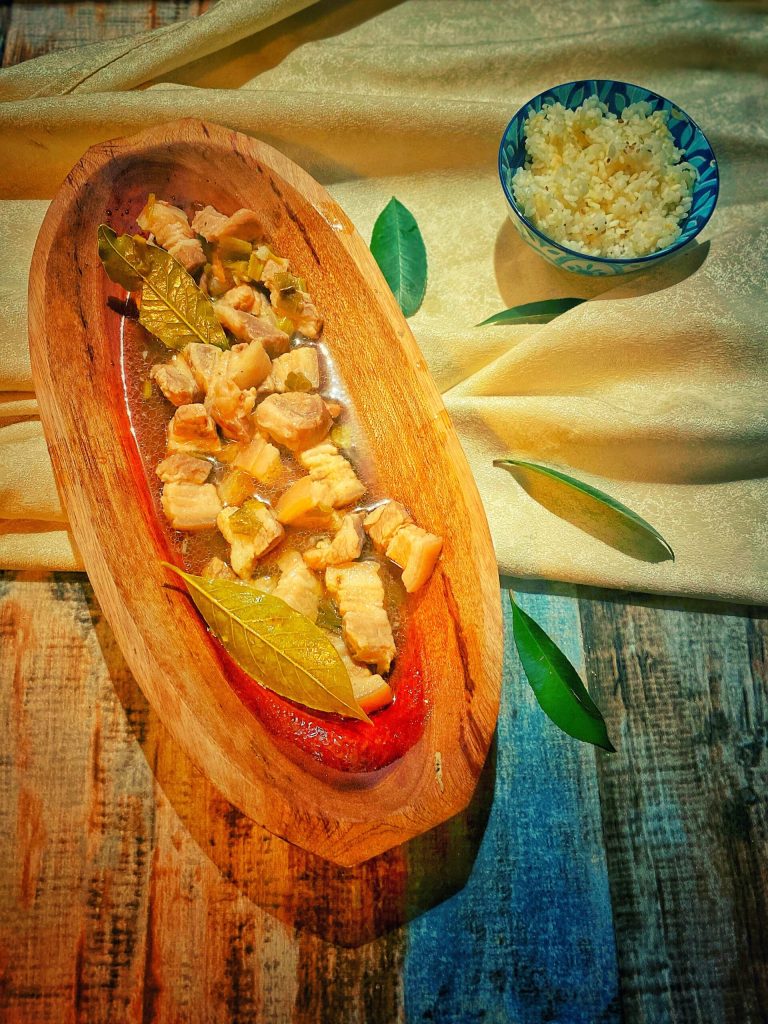The Pork adobo, or Adobong Baboy, from the Philippines is braised pork belly in vinegar, soy sauce, garlic, and onions.
But other cuts, such as chops, thighs, hocks, and ribs, are good options too.
The Filipino adobo is more broadly a cooking technique in which meat, seafood, or vegetables are braised in a mixture of vinegar with seasonings like garlic, onions, peppercorns, and bay leaves.
There is a rarer version without soy sauce known as adobong puti: “white adobo,” to contrast with adobong itim “black adobo,” the more common versions with soy sauce.
It was initially a way to preserve food, with pre-colonial Filipinos preparing meat and seafood in vinegar and salt to extend their shelf life.
The vinegar, in particular, is one of the most important ingredients in Filipino cuisine, and there are 4 vinegar-based cooking methods:
– kiniláw (raw fish in vinegar and spices),
– paksíw (a meat broth with vinegar and spices),
– sangkutsá (pre-cooked braised meat in vinegar and spices)
and finally adobo.
Usually, it is coconut vinegar, rice vinegar, or cane vinegar (white wine vinegar or cider vinegar can also be used).
Pork adobo is best enjoyed with steaming hot rice and is commonly found on Filipino breakfast menus, as a meal called “adosilog” (adobo, fried rice, and fried egg).
Additionally, adobo meat is also used as a filling for bread like siopao (Filipino steamed buns) or pandesal, the common Filipino oven-baked bread roll.

- Difficulty: Easy
- Cost: Affordable
- Rest time: 30 Minutes
- Preparation time: 10 Minutes
- Portions: 2 people
- Cooking methods: Slow heat, Stovetop, Slow cooking
- Cuisine: Filipino
- Seasonality: All seasons
Ingredients
- 2 lbs fresh pork belly (or other pork cuts)
- 1 onion
- 2 leaves bay leaves
- 1 cup coconut vinegar (or rice, cane, cider, or white wine vinegar)
- 0.4 cup soy sauce
- 1 cup water
- to taste salt and pepper
- to taste vegetable oil
Steps
Cut the pork belly and marinate it with onion, garlic, bay leaves, salt, and pepper in the refrigerator for at least 30 minutes.

Arrange the pork belly in a pan with a drizzle of oil, add vinegar and boil for 3/5 minutes uncovered, without stirring.
Then add the soy sauce, water, and stir.
Lower the heat, cover, and cook for about 40/50 minutes.
Serve with steamed white rice.

FAQ (Questions and Answers)
What other types of adobo exist?
The most common types of adobo are:
adobong manók, using chicken, and adobong baboy (pork adobo), using pork.
Adobong Baka (beef), along with adobong manók (chicken), is more popular among Muslim Filipinos in accordance with halal dietary laws.
Other meats such as pugò (quail), itik (duck), and kambíng (goat) can also be used.
Seafood variants include fish (isdâ), catfish (hitò), shrimp (hipon), squid or cuttlefish (pusit).
Vegan options use fruits and vegetables, such as water spinach (Kangkóng), bamboo shoots (labóng), eggplant (talong), banana flowers (pusô ng saging), and okra (gombo).
Adobong puti is often considered the closest to the original pre-Hispanic adobo. It is similar to another dish known as pinatisan, where patis (fish sauce) is used instead of vinegar.
Adobong dilaw (“yellow adobo”) uses kalawag (turmeric) to provide the yellow coloring and add a different flavor, and can be found in the regions of Batangas, Visayas, and Mindanao.

